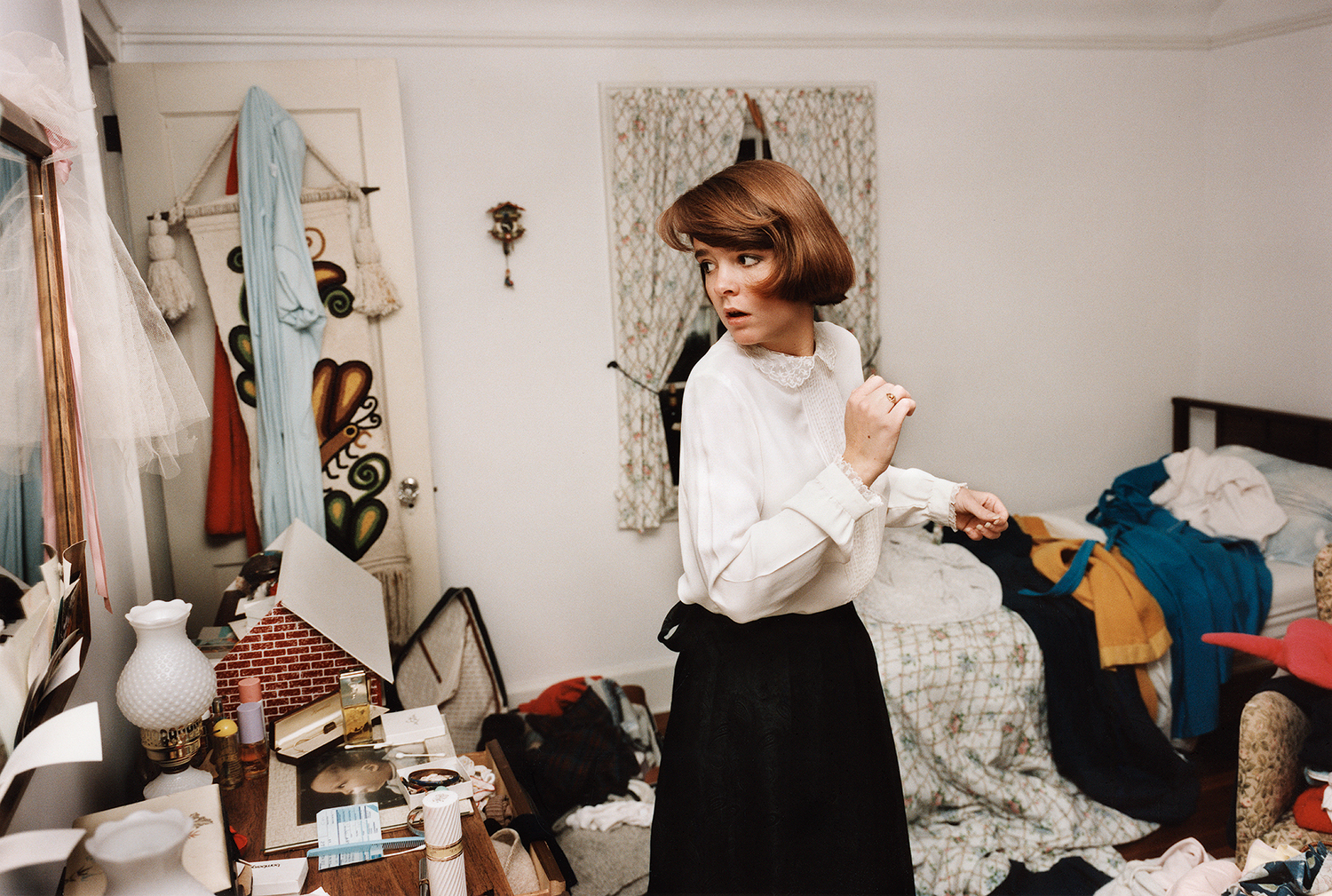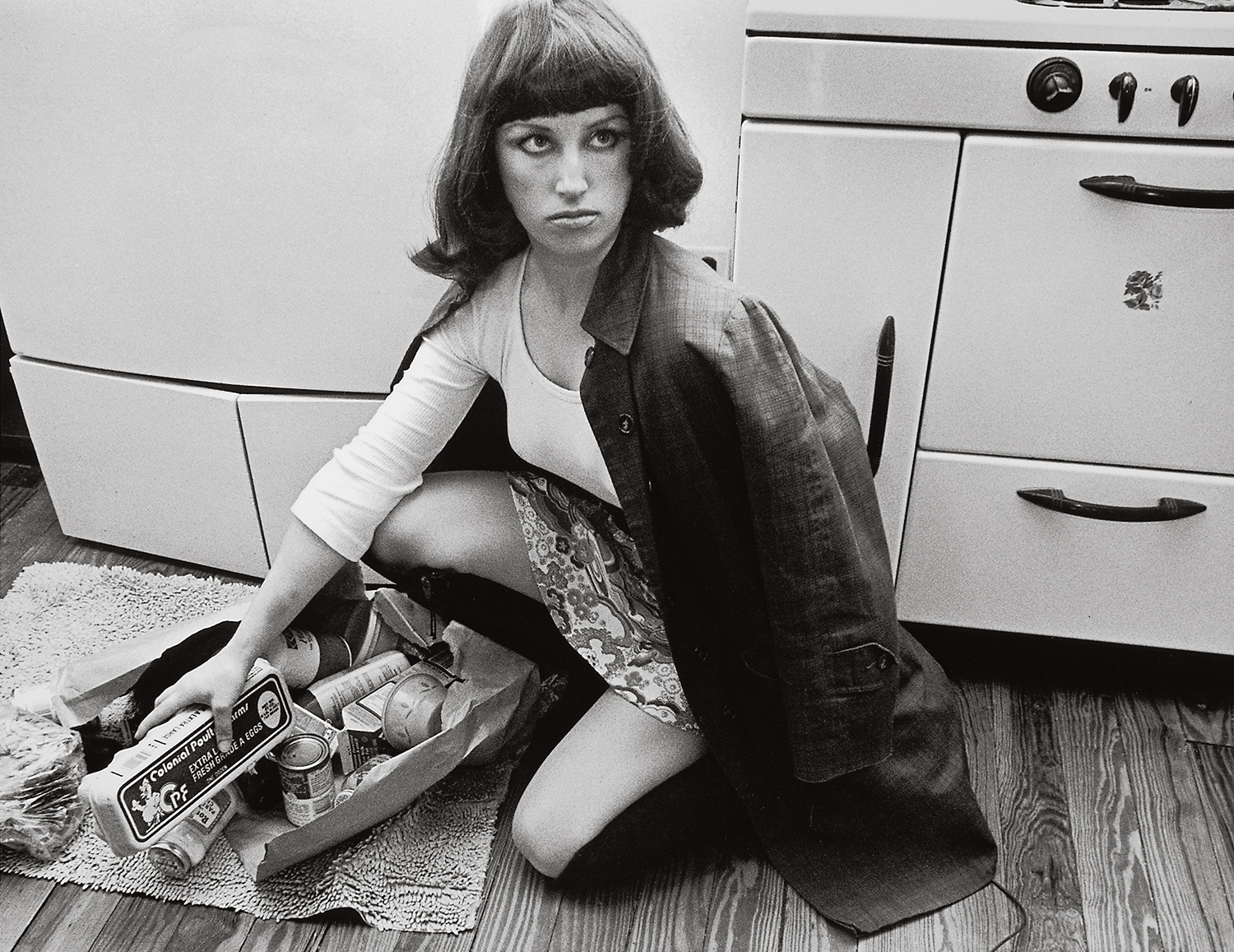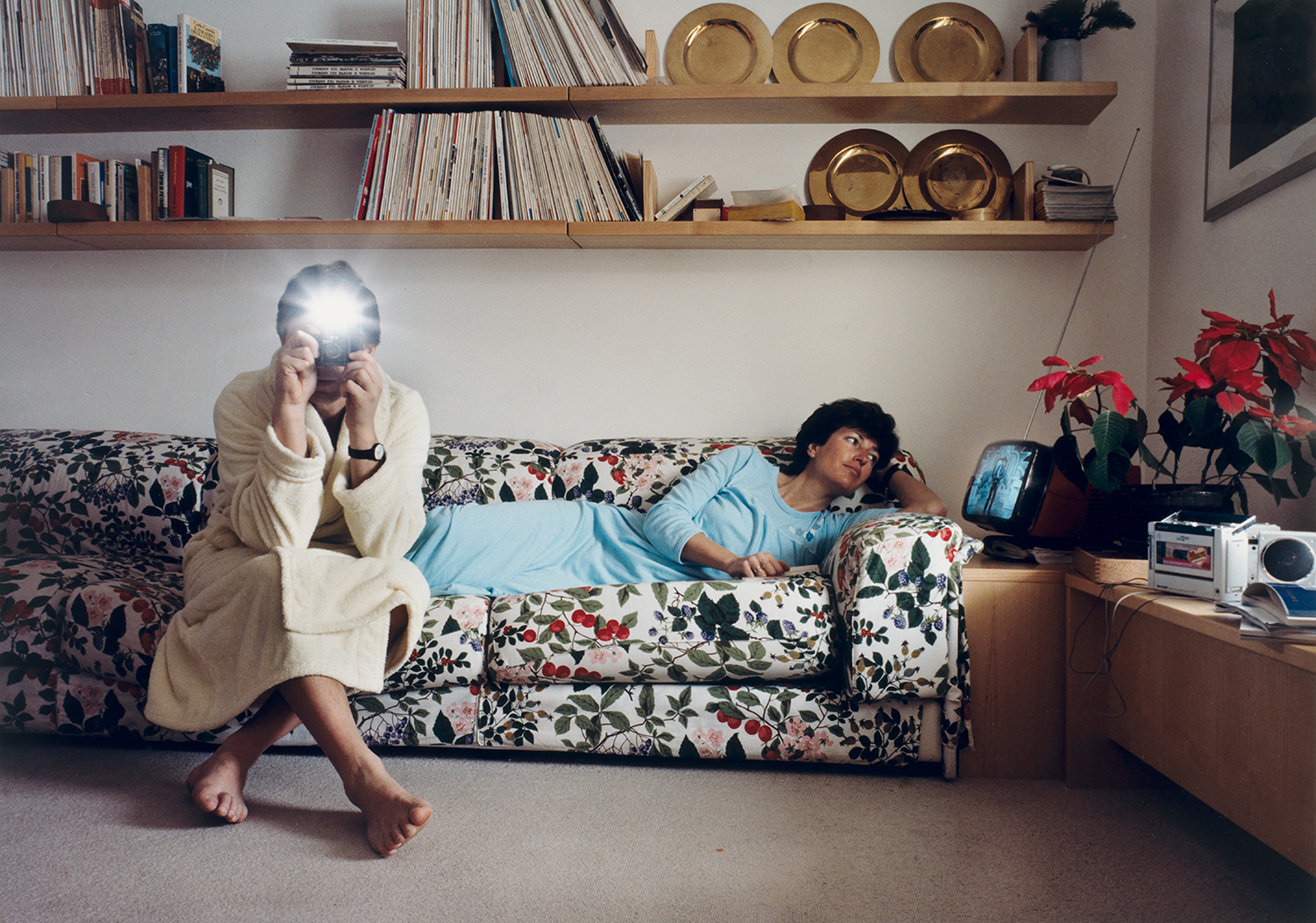The Terror and Pleasure of Staying at Home
In 1991, the Department of Photography at the Museum of Modern Art in New York staged Pleasures and Terrors of Domestic Comfort, among its most ambitious group exhibitions since The Family of Man in 1955. While The Family of Man sought to universalize human experience by surveying journalistic images of familial bonds and rituals from around the globe, Pleasures and Terrors looked squarely at a narrow swathe of distinctly American life: the home and, more pointedly, its affluent surfaces. (“Comfort,” after all, implies not only the rounded edges of cozy furniture, but the economic ease that affords them.) Curated by Peter Galassi, who would formally succeed John Szarkowski as head of the department during the show’s run, it included over 150 images by more than seventy artists. Pleasures and Terrors marked a shift in interest, by both photographers and their subjects, from the politics of the wider world and even from the street outside, toward the warm, lit living rooms of American domestic life. What might we understand of this moment if we take the time to wander back through some of these homes today?
With the exception of William Eggleston’s 1970s images—Eggleston being the hero then as now of recasting the mundane as monumental—most of the works in the show were made in the 1980s. After Watergate and Vietnam, after Margaret Thatcher, Ronald Reagan, and George H. W. Bush, the politics of social concern gave way to a tidal wave of late-capitalist individualism and aspiration. A culture of slogans and protests retreated inside to the solace of TV and tchotchkes. Galassi explained it this way:
It became all too reasonable to conclude that moral conviction and political effectiveness, at least on a national scale, had parted company forever. If there is any truth in these partisan simplifications, then perhaps an effort to get one’s own house in order, or at least to see it clearly, will seem less a withdrawal from responsibility than an expression of sanity.
The American dream, it seems, is alive and well, if a little frayed at the edges.

Courtesy the artist
On the surface, there were the usual snapshot-worthy events in the exhibition: babies and backyards, Christmas trees and card games. The plethora of patterns and interior decor is one of the pleasures of looking back. Indeed, the show drew attention from Elle Decor, House Beautiful, and Parenting, which all ran lighthearted notices. The soft pinks of Laurie Simmons’s Coral Living Room with Lilies (1983) and the typical youthful mess of Doug DuBois’s My Sister Lise, Christmas Eve, Far Hills, NJ (1984) give us a feeling for the palettes and textures of the time, the kinds of pictures that might provoke nostalgia in a certain generation or inspire Pinterest mood boards or period cinema now. Set against the backdrops of enviable domestic spaces, the kind we might find in advertising images for perfect kitchens or in home-decorating magazines, the subtler hints of disquiet can be missed.
Yet the stark undertone and palpable discomfort in many of the images, often overlooked at the time, are unmistakable from this perspective—though one also wonders if the past always looks a little melancholy. The cinematic stagings of Philip-Lorca diCorcia and Tina Barney are dramatically forlorn, suggestive of larger narratives that never quite unfold. The young boy in diCorcia’s Brian (1988) looks glumly at a large hunk of meat, the counter awash with piles of food and gadgets. In Sergio and Totti (1985) a couple in loungewear sit on a floral couch looking away from one another, one watching television, the other obscured by the camera’s flash, as he—presumably Sergio—documents his own documentation. (Interestingly, the exhibition also utilized television as a promotional tool, a medium that museums had long eschewed. A three-minute spot for a short-lived PBS culture show called The Edge broadcast an unnarrated montage of images from the exhibition interspersed with audio clips from popular TV shows and Hollywood movies of the era, making an implicit connection between popular dramatizations of domestic life and those displayed in the MoMA exhibition.)

Courtesy the artist and Kasmin Gallery, New York
Barney’s Sunday New York Times (1982) shows a big family orbiting a table, the newspaper spread across it, in a warm-yellow room. A woman in the corner holds a baby and scowls ineffectually at a man in the foreground intently reading the news, oblivious to the baby bottle beside him and the chaos that surrounds. Similarly, The Landscape (1988) depicts a group sharing space but distinctly lost in their own worlds, the youngest a blur of blonde curls in the foreground. Though they are crowded together in the center of the frame, each person, even the dog, looks away. A gilt-framed painting echoes the blues and greens outside a bay window in the room beyond, layering natural and contrived landscapes. However enviable the real estate or ornamentation, otherwise gracious rooms are also filled with less tangible things—loneliness, resentment, desire, and uncertainty.
If the show is remarkable in its expression of such subtlety of feeling, this comes in part from the work of the many women photographers included (about half ), whose projects look unflinchingly at the subjects of motherhood, domestic labor, and the wider expectations of girls and women near the close of the twentieth century. The show brought together poetic documents of intimacy in the work of Sally Mann, Marilyn Nance, and Jo Ann Walters, whose thirty-year project, only just published in 2018, began with the image of a family in a Connecticut backyard included in Pleasures and Terrors. In many photographs, like Barney’s, or those of Mary Frey, women appear conspicuously as mothers and wives, often the less powerful figures in the frame. As if in challenge to them, selections from Carrie Mae Weems’s Kitchen Table Series (1990) and Cindy Sherman’s Untitled Film Stills (1977–80) sought to reconsider these expectations from the inside out. In these projects, placed side by side in the catalog, Weems holds her cards close to her chest and looks sidelong at her male companion, while Sherman crouches to collect her fallen groceries, gazing intently beyond the frame. Who are we, in your eyes, they each ask, and who do we want to be?

Courtesy the artist and Metro Pictures, New York
The emphasis on female practices is significant, though it’s also curiously glossed over in the catalog essay. Indeed, Galassi writes that “photographers, like businessmen, generally have maintained a barrier between work and home.” Such a statement ignores the fact of domestic labor, the business of keeping house, long a cultural expectation of women and one that extended to maintaining a photographic record of the family. The photographers Rosy Martin and Jo Spence have suggested in their extraordinary work on the culture and aesthetics of the family album that, as a genre, it is beholden to a set of conventions and expectations. “Family snaps,” they write, “hardly give any indication of the contradictions, power struggles or desires inherent at all levels of family life, or in the intersection of that life with the structures which make up a patriarchal society with sexual, racial and class divisions.” In retrospect, Pleasures and Terrors is striking not only as a powerful expression of the significance of the domestic sphere, but as an opening up of its complicated dynamics, often through the eyes of women working in the wake of second-wave feminism and ushering in the third.

Courtesy the artist and Salon 94, New York
Pleasures and Terrors also had a number of clear gaps, some acknowledged openly at the time, others more starkly visible from a distance. Galassi makes brief note of some omissions, writing that “a great deal is missing. Racially, ethnically, and economically the pictures are far from representative of contemporary America.” He fails to account for these gaps, however, other than to group them together with what he calls “the journalistic favorites of domestic trouble—homelessness, drug abuse, child abuse, violence,” suggesting such subjects belong to a realm that is somehow in opposition to or outside the bounds of art. This division is disturbing, a circuitous excuse releasing the museum from any sense of social responsibility. With the exception of images by Weems and Nance, most display white, heteronormative figures. Carol Squires wrote at the time that Weems’s image “raises a variety of questions, not least among them whether a black female photographer has ever been shown before by MoMA’s photography department.” And most omit the violence, physical or psychological, that is often wrought in the home. The exception was Nan Goldin’s slideshow The Ballad of Sexual Dependency (1986), which contains a more complex idea of family and of the brutality of desire—though it screened only once, for an extra cost of eight dollars. Like the omission of the nuclear explosion in The Family of Man, there is a void at the center of the exhibition’s contents that hollows out both critical and moral perspectives.
This problem is inherently one of self-reflection and is hinted at, even if obliquely, in the sheer number of images that contain mirrors, or, in the case of diCorcia’s Sergio and Totti, the camera’s flash. A trick of domestic decor and a trope of self-reflection, mirrors enact a visual deceit and enable vanity. In hindsight, the show’s failings made clear the willful blindness to a diversity of perspectives and lifestyles, a circumstance that began to be redressed by artists, including Catherine Opie and Alec Soth, who have credited Pleasures and Terrors as a catalyst for their work. Opie drove an RV around the country to make her series Domestic (1998), which pictures everyday lesbian domestic life in America, in response to Pleasures and as part of a conversation with Galassi. Soth, who was a college student when he saw the exhibition, has credited it with making “domestic life seem like a worthwhile subject for photographers,” a subject he’s pursued, loosely, in his varied pictures of American life, including Broken Manual, which documents the desire to abandon the comforts of home in favor of a reclusive existence off the grid.

Courtesy the Museum of Modern Art, New York/Art Resource, New York
Curators were equally attuned to the significance of Pleasures and Terrors, and a number of exhibitions looking at domesticity and everyday life sprung up in its wake, most notably Snapshots: The Photography of Everyday Life at the San Francisco Museum of Modern Art in 1998, Who’s Looking at the Family? at the Barbican in 1994, and, over a decade later, the similarly oppositional photography exhibition Cruel and Tender: The Real in the Twentieth- Century Photograph at Tate Modern in 2003. Pleasures and Terrors is notable as the first encompassing exploration of the translation of the “snapshot aesthetic” into formal, monumental museum photography (and, it should be said, for the rise of an art market that would support such works—pictures made as much of the subjects as for their big empty walls). Galassi also understood intuitively the way that it would connect with wider audiences.
At a time when museums had to adapt to survive, the relevance of photography as a document of everyday life became crucial. Pleasures and Terrors was important not only for opening up new photographic territory for future generations, but for legitimizing the subject of everyday life within the history of the medium, and within the parameters of the public art museum. And as an extension, Pleasures and Terrors also preluded the deluge of images that would define social media within a decade.
The ambiguity of pleasure is played out endlessly in the contradictions of our enjoyment and our pathological projection of enjoyment, and in the dissolution of the boundaries between private and public.

Courtesy the artist and Foley Gallery, New York
Galassi seems to have found a poetic name in a riff on the title of Aaron Siskind’s 1954 series The Pleasures and Terrors of Levitation (Siskind died in February 1991, as the show was being planned). The photographs depict bodies suspended dramatically in midair, perhaps floating, perhaps falling, their beauty complicated by the uncertainty of their peril or safety. Though Siskind’s images are neither domestically themed nor included in the exhibition, the tension between aesthetic pleasure and lurking threat evident within them is an apt analog for the themes of Galassi’s show.
Myopic as it was, Pleasures and Terrors opened up a conversation about what it might mean to be American, not from a view of patriotism or warfaring, but from an internal perspective of private life. It can be retrospectively understood as a fulcrum for its historical moment, connecting back to Edward Steichen’s imperialist vision of a collective view of human experience in The Family of Man and to John Szarkowski’s predilection for poetic subjectivity. But it also pointed out the problems of those histories and looked forward to the future, toward the demise of privacy, the loneliness of late capitalism, and the significance of image and identity culture in shaping our perceptions of gender, class, and race. Pleasures and terrors, the show suggests, are like holograms, embedded within one another, twisting and changing according to the slant of light.
Read more from Aperture, issue 238, “House & Home,” or subscribe to Aperture and never miss an issue.


























